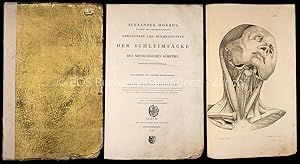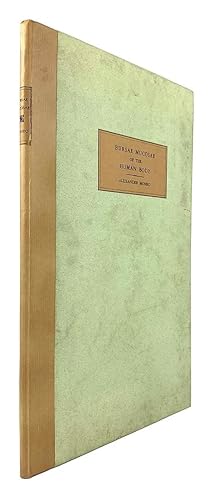MONRO, ALEXANDER SECUNDUS (6 résultats)
Type d'article
- Tous les types d'articles
- Livres (6)
- Magazines & Périodiques
- Bandes dessinées
- Partitions de musique
- Art, Affiches et Gravures
- Photographies
- Cartes
-
Manuscrits &
Papiers anciens
Etat
- Tous
- Neuf
- Ancien ou d'occasion
Reliure
- Toutes
- Couverture rigide (3)
- Couverture souple
Particularités
- Edition originale (3)
- Signé
- Jaquette
- Avec images (2)
- Sans impression à la demande
Pays
Evaluation du vendeur
-
Knochenlehre, nach der Ausgabe des Herrn Sue übersetzt . Nebst der Nervenlehre eben dieses Verfassers, u. einer Erklärung v.d. abweichenden Bewegungen des Herzens, wie auch einer Beschreibung des menschl.
Date d'édition : 1761
Vendeur : Antiq. F.-D. Söhn - Medicusbooks.Com, Marburg, Allemagne
Livre Edition originale
Milchsaft-Behälters . a.d. Englischen v. C.Krause. - Leipzig, Fritsche, 1761, Kl.8°, (8), 649, (3) pp., Kalbsledereinband der Zeit mit Rückenvergoldung. Erste Ausgabe dieser seltenen deutschen Übersetzung dieses Klassikers der Osteologie. Alexander Monro (1697-1767) "primus", wie er gewöhnlich genannt wird, war der erste in der langen Linie der Professoren-Familie der Monros, die, mit Unterbrechungen, über einen Zeitraum von über 120 Jahren den Lehrstuhl für Anatomie an der Univeristät Edinburgh inne hatte. Monro war ein Schüler von Boerhaave und Cheselden und unter seiner Leitung wurde Edinburgh zu einem Zentrum der Medizin. Seine "Anatomy of human bones" war in verschiedenen Auflagen für mehr als ein halbes Jahrhundert eines der Standartwerke der Medizin. -- Von besonderem Interesse sind die Kapitel "Von der Substanz- und Erzeugung der Knochen", "Von den Articulationen", "Von den Bändern und Knorpeln", etc. Die Knochenlehre ist durch ein ausführliches Register erschlossen. Die neuroanatomischen Studien Monros gipfelten in den bekannten Entdeckungen seines Sohnes Monro secundus. Gelenke etwas gelockert, sonst gutes Exemplar. Im Register zur Nervenlehre fehlt das letzte Blatt mit den Buchstaben O-Z.
-
Abbildungen und Beschreibungen der Schleimsäcke des menschlichen Körpers. Umgearbeitet und vermehrt herausgegeben von Johann Christian Rosenmüller.
Edité par Leipzig, Breitkopf und Härtel., 1799
Vendeur : EOS Buchantiquariat Benz, Zürich, Suisse
Folio. XII, 108 S. Mi 15 Kupfertafeln. Pappband aus der Zeit mit erneuertem Rücken. Hirsch-H. IV, 243. Blake 309. Erste deutsch-lateinische Parallelausgabe nach der englischen Ausgabe von 1788 «Description of all bursae mucosae of the human body». Gegenüber der englischen Ausgabe um 5 Tafeln erweitert. Titel mit altgetilgtem Bibliothekstempel. Die zwei letzten Tafeln mit Beschädigungen ausserhalb der Darstellungen. Buchblock und Einband stark bestossen. Sprache: deutsch / german. + Wichtig: Für unsere Kunden in der EU erfolgt der Versand alle 14 Tage verzollt ab Deutschland / Postbank-Konto in Deutschland vorhanden +.
-
A Description of all the Bursae Mucosae of the Human Body; their structure explained, and compared with that of the capsular ligaments of the joints, and of those sacs which line the cavities of the thorax and abdomen; with remarks on the Accidents and Diseases which affect those several Sacs, and on the Operations necessary for their cure. Illustrated with tables.
Edité par Edinburgh: Printed for C. Elliot T. Kay and Co, 1788
Vendeur : Forest Books, ABA-ILAB, Grantham, LINCS, Royaume-Uni
Edition originale
First Edition, folio (470 x 290 mm), [5], 6-60pp., 10 engraved plates (4 folding on 2 sheets joined) after A. Fyfe and Thomas Donaldson, plates II and III with short tears not touching the image, plate V a little creased with short closed tears, nineteenth-century half calf, rubbed, covers detached. This was "The first serious study of this subject and the most original anatomical work by the greatest of the Monro dynasty." It contains the first full anatomical description of the sacs between the tendons and bones which Albinus had named the bursae mucosae. They are illustrated on the ten plates "which for explicit clarity and accuracy have not been improved upon." (Heirs of Hippocrates 1011). The plates depict the foot, various joints including the knee and hip, and four of the plates are life-sized representations of the entire arm and leg. Monro secundus' earlier publications were largely polemical, and it was not until he had been teaching for twenty-five years that his three main contributions to medical literature appeared. Monro's Observations on the Structure and Functions of the Nervous System (Edinburgh, 1783), a massive text and atlas on human and comparative neurology, is Monro's greatest work. His Description of All the Bursae Mucosae of the Human Body. was a practical manual for direct use in surgery. Although next to nothing was known of germ life at that time, Monro's acute observation and independent empirical judgement led him to the conclusion that the chief danger of infection in surgery of joints lay in exposure to the air. Garrison-Morton, 399.2; Blake, p.309; Heirs of Hippocrates 1011; Wellcome, IV, p.156. Russell, British anatomy, 613. Taylor, The Monro Collection, M170.
-
A Description of All the Bursae Mucosa of the Human Body; Their Structure Explained, and compared with that of the capsular ligaments of the joints, and of those sacs which line the cavities of the thorax and abdomen; with remarks on the accidents and diseases which affect those several sacs, and on the operations necessary for their cure. Illustrated with Tables. By Alexander Monro, M.D.
Date d'édition : 1788
Vendeur : Patrick's Rare Books, IOBA, Hudsonville, MI, Etats-Unis
Membre d'association : IOBA
Livre Edition originale
Hardcover. Etat : Very Good. 1st Edition. A Description of All the Bursae Mucosa of the Human Body; Their Structure Explained, and compared with that of the capsular ligaments of the joints, and of those sacs which line the cavities of the thorax and abdomen; with remarks on the accidents and diseases which affect those several sacs, and on the operations necessary for their cure. Illustrated with Tables. By Alexander Monro, M.D. Professor of Physic, Anatomy, and Surgery, in the University of Edinburgh; Fellow of the Royal College of Physicians and of the Royal Society of Edinburgh; and Fellow of the Royal Academy of Surgery of Paris. Edinburgh: Printed for C. Elliot, T. Kay, and Co. No. 332, opposite Somerset-Place, Strand, London; And for Charles Elliot, Edinburgh. 1788. Folio in blue-green paper over boards with brown paper spine. Brown paper title plates on front board and spine. Boards smudged. New end papers. Three leaves (including title) with marginal paper repairs. Small tears at fore-edge of Tab VIII (not affecting image). Deckled edges. Margins enormous. A few very small, ink stains. Minimal foxing and toning. Otherwise, clean, bright, and tight throughout. New ffep, blank, title, to Royal Society and Contents, 5 10 text, Tab 1 (top), 11 12 text, Tab II (top), 13 14 text, Tab III (top), 15 16 text, Tab IV, Tab V, 17 20, Tab VI, Tab VII, 21 54, Tab 8 (folding), 55 58, Tab 9, 59 60, Tab X, Tab I (bottom), Tab III (bottom, folding), unnumbered folding plate, original blank, new blank. We have seen two states for this work. Some copies have the folding plates laid on linen so the tops and bottoms of the plates are together. In others, like this copy, the leaves were never brought together to unite the portions of the plates, so a bit of flipping and letter-hunting is necessary to correlate the images with the explanations when identifying structures. Alexander Monro Secundus (1733 1817) is generally regarded as the greatest of the three Alexander Monros (they held, in turn, the Chair of Anatomy at Edinburgh from 1720 to 1846 (Thornton, 1966). Secundus studied under his father, Primus, as well as Hunter, Albinus, and Meckel the Elder. Indeed, it was Albinus who named the bursae mucosae (Heirs of Hippocrates 634 and 635). Secundus is the one who is credited with the discovery of the eponymous Foramen of Monro in the brain (see Garrison Morton 1385, and Waller. 6645 and 6646). G-M 399.2 The first serious study of this subject and the most original anatomical work by the greatest of the Monro dynasty. 
-
The Structure and Physiology of Fishes Explained, and compared with those of man and other animals.
Edité par Edinburgh: Printed for Charles Elliot,?and G.G.J. and J. Robinson, London, 1785., 1785
Vendeur : Nigel Phillips ABA ILAB, Chilbolton, Royaume-Uni
Large folio, 128 pages, and 50 engraved plates on 44 sheets (including 12 folding). Short tear in the fold of plate I (very large and folding), plate number of plate XX shaved, clean cut across plate XXIV without loss. Early 19th century green half calf, marbled paper sides rubbed and with some areas of the marbling missing, joints and corners rubbed, small crack at foot of lower joint, but a very good copy. FIRST EDITION, issue with London in the imprint. ?The first important Edinburgh textbook on comparative anatomy, a subject that had been recently introduced to their London students by the Hunters? (DSB). The fine life-sized plates, from actual dissections, are mostly from drawings by Andrew Fyfe or Thomas Donaldson and are printed on thick paper of excellent quality. Cole Library 1660. Taylor, The Monro Collection, M172 (issue without London in the imprint). Casey Wood p. 470: ?A treatise of much value.?.
-
The Structure and Physiology of Fishes
Edité par 0
Vendeur : Brainbooks, Gainesville, FL, Etats-Unis
Livre
Hardcover. Etat : Very Good. Alexander Monro [secundus]: The Structure and Physiology of Fishes Explained, and Compared with those of Man and Other Animals. Illustrated with Figures. By Alexander Monro, M.D. Fellow of the Royal College of Physicians, and of the Royal Society, and Professor of Physic, Anatomy, and Surgery, in the University of Edinburgh. Edinburgh : Printed for Charles Elliot, Edinburgh; and G.G.J. and J. Robinson, London, 1785. FIRST EDITION, issue with the London imprint. Tall elephant folio (48 x 30.5 cm; 19 x 12 in.) in modern burgundy half morocco and brown buckram, new endpapers; 128 pp.; 49 copper-engraved engraved plates on 43 [of 44] sheets. ESTC T97697 Deaccessioned from an institutional research library, with its gilt-stamp to the spine foot and ink stamps on the title-page and plates. Lacking the first plate leaf, but with what appears to be at least part of that plate leaf reproduced in pencil, mounted on a stiff backing and loosely laid in (see below). Binding with a few touches of wear to the extremities, front hinge starting to crack at the head and foot but front board is secure; some scattered, mostly light foxing, occasional soiling to the page and plate edges, one or two plates with short closed tears at the folds; otherwise clean and sound, firmly bound. An extraordinary collection of large plates (measuring up to 28.5 x 18.5 in.) with accompanying notes, preceded by several explanatory chapters, including A Description of the Heart, Vessels, and Circulation of the Blood in Fishes; Of the first Discovery of the System of Absorbent Lacteal and Lymphatic Vessels in Birds, Fishes, and Amphibious Animals; Of the Eyes in Fishes; Experiments on Hearing in Water; etc. "The first important Edinburgh textbook on comparative anatomy, a subject that had been recently introduced to their London students by the Hunters [William and John]" (Dictionary of Scientific Biography). Alexander Monro (1733-1817), called secondus to differentiate him from his father, Alexander primus, and son, Alexander tertius, was a leading Scottish anatomist, surgeon and medical educator with "an insatiable thirst for medical knowledge, an uncommon share of perseverance, and a very good memory" (Wikipedia). Extra shipping for this huge book is required. Photos available.




